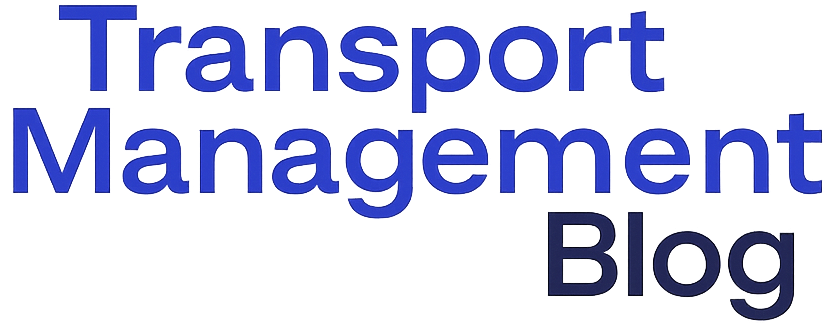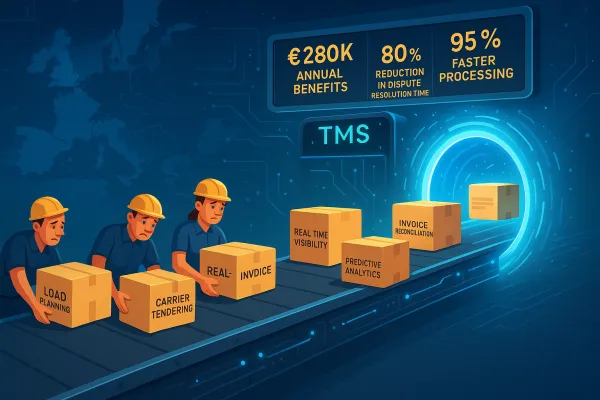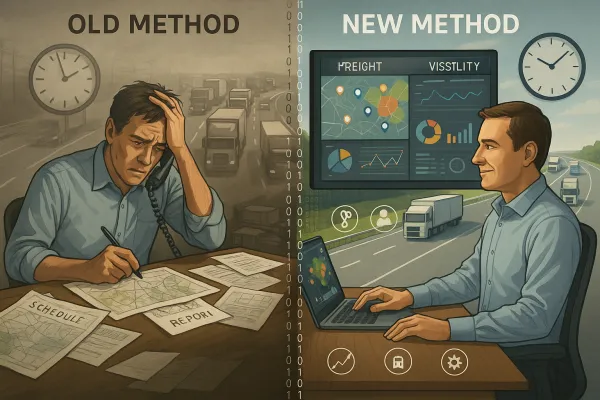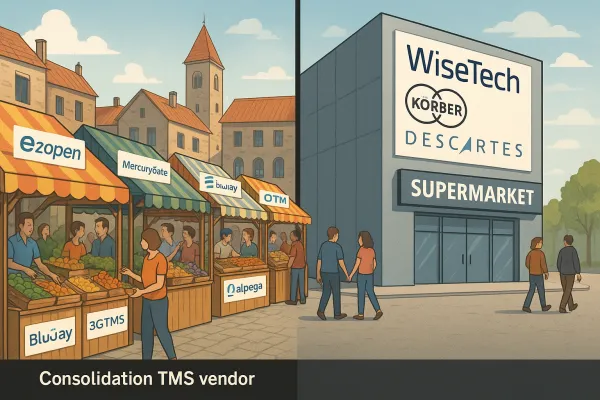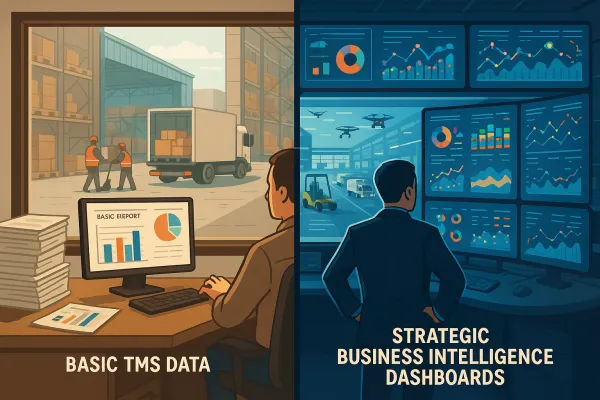From Manual to Digital: How Modern TMS Platforms Transform Transport Tender Management for European Shippers
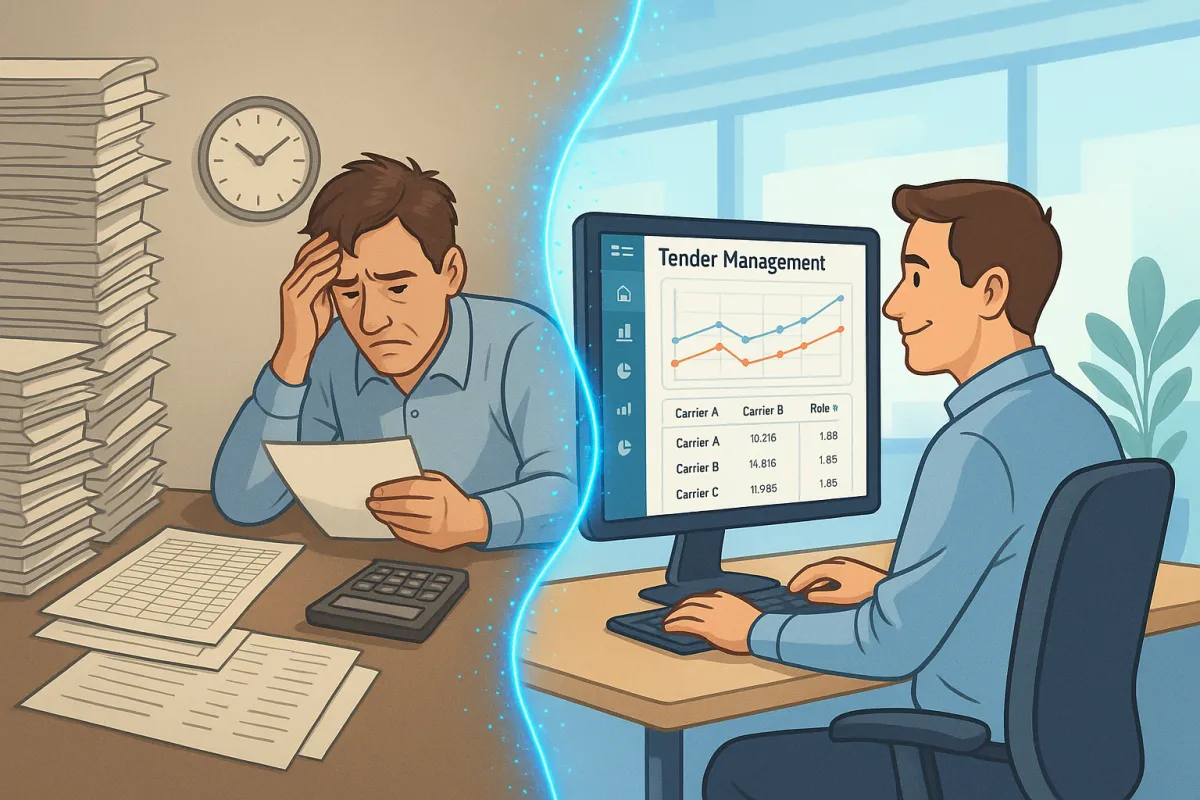
Your European procurement teams spend weeks preparing transport tenders, managing carrier responses, and comparing rates across dozens of proposals. Sound familiar? The European TMS market reached €1.4 billion in 2024 and is growing at 12.2% annually, driven by companies transforming these manual processes into automated, data-driven procurement strategies.
Modern transport tender management through TMS platforms can reduce procurement cycle times by 60% while delivering measurable cost savings. Here's how to make the transition from spreadsheet-driven tendering to strategic digital procurement.
The Hidden Costs of Manual Transport Tendering
Manual tendering processes consume far more resources than most companies realize. A typical annual transport tender for a mid-sized European manufacturer involves 3-4 weeks of preparation, managing responses from 15-25 carriers, and another 2-3 weeks analyzing proposals. Your procurement team spends roughly 240 hours on a single tender event.
The real cost extends beyond time investment. European road freight rates fell 2.3 points in Q1 2025 for contract rates, yet many companies miss these market opportunities because their tender cycles are too infrequent or poorly timed.
Manual processes also limit carrier participation. Smaller regional carriers often avoid complex tender requirements, reducing your options for specialized routes or capacity during peak seasons. A German automotive parts supplier I worked with discovered they were missing 40% of potential carrier partners simply because their tender documentation was too cumbersome.
The evaluation phase presents another challenge. Comparing proposals across different rate structures, service levels, and terms requires significant analysis. Without proper tools, procurement teams often default to price-based decisions, missing opportunities to optimize for service quality or strategic partnerships.
Key TMS Features That Transform Tender Management
Modern TMS platforms offer specific capabilities designed for transport procurement automation. The most valuable features address the pain points of manual tendering while enabling more strategic decision-making.
Automated RFP creation and distribution handle the administrative burden of tender management. Platforms like Cargoson, Transporeon, and Alpega allow you to create standardized tender templates, automatically populate route requirements from historical data, and distribute proposals to pre-qualified carrier networks. This reduces preparation time from weeks to days.
Real-time bid comparison tools provide visibility into carrier responses as they arrive. Instead of waiting for the tender deadline, you can monitor participation rates, identify missing responses, and adjust requirements if needed. Blue Yonder and Descartes offer sophisticated simulation capabilities that model different award scenarios before final decisions.
Carrier network integration expands your procurement reach beyond existing relationships. Established platforms connect to thousands of European carriers, automatically matching your requirements with qualified providers. MercuryGate and Manhattan Active integrate with major carrier networks, while newer solutions like Cargoson focus specifically on European mid-market shippers.
Rate benchmarking capabilities help validate proposal competitiveness. Instead of relying on historical rates or market intuition, you can compare offers against current market indices. This proves particularly valuable given the current European market conditions where shippers have favorable bargaining power.
Step-by-Step Implementation Strategy
Preparation Phase: Audit Current Processes
Start by documenting your existing tender workflows. Map every step from requirement gathering to carrier onboarding. Identify bottlenecks, manual touchpoints, and areas where errors commonly occur. This baseline measurement becomes crucial for demonstrating ROI.
Evaluate your current carrier base against available network connections. Most European shippers work with 20-30 regular carriers but could benefit from access to 200-300 qualified providers. Review your contract terms and identify standardization opportunities.
Setup Phase: Define Requirements and Parameters
Create standardized tender templates covering your common lane types, service requirements, and evaluation criteria. Define clear scoring methodologies that weight price, service quality, and strategic factors. This standardization enables faster future tenders while ensuring consistent evaluation.
Establish carrier qualification criteria and onboarding processes. Modern TMS platforms handle much of this automatically, but you need clear standards for insurance requirements, service capabilities, and performance metrics.
Execution Phase: Launch Automated Distribution
Use the platform's carrier network to identify qualified providers for your specific routes. Target 25-35 carriers per tender to ensure competitive tension while maintaining manageable response volumes. The system handles distribution, tracks responses, and manages communication automatically.
Monitor participation in real-time and adjust strategies as needed. Low response rates might indicate unrealistic requirements or insufficient lead time. High response rates suggest strong market interest and potential for aggressive pricing.
Analysis Phase: Optimize Carrier Selection
Leverage simulation tools to model different award scenarios. Test various combinations of primary and backup carriers, evaluate cost-service trade-offs, and assess risk factors. Modern platforms can model hundreds of scenarios in minutes.
Use benchmarking data to validate final decisions. Compare awarded rates against market indices and peer performance. This data proves valuable for future negotiations and budget planning.
Measuring Success: KPIs and ROI Metrics
Track procurement cycle time as your primary efficiency metric. Measure from tender launch to contract execution. Leading companies achieve 4-6 week cycles for complex multi-modal tenders, compared to 8-12 weeks with manual processes.
Monitor cost optimization results carefully. Focus on total cost of ownership rather than just rate reductions. Factor in service improvements, reduced administration costs, and risk mitigation benefits. A European retail chain I worked with achieved 8% total cost savings while improving service quality scores.
Measure carrier participation rates and diversity. Increased participation typically correlates with better rates and service options. Track the percentage of new carriers versus existing relationships to ensure you're expanding your network effectively.
Evaluate carrier performance benchmarking capabilities. Modern TMS platforms like E2open/BluJay and 3Gtms/Pacejet provide detailed analytics on delivery performance, damage rates, and service quality. Use this data to refine future tender criteria and carrier selections.
Avoiding Common Implementation Pitfalls
Don't prioritize price alone over strategic partnerships. Automated tendering makes it easy to focus solely on rates, but the cheapest option often proves most expensive long-term. Maintain relationships with reliable carriers even if their rates are slightly higher.
Manage tender fatigue carefully. Excessive tendering frequency can damage carrier relationships and reduce participation quality. Most European routes benefit from annual or bi-annual tendering, with quarterly spot market testing.
Account for market capacity fluctuations in your tender timing. European road freight rates show seasonal patterns, and tender timing significantly impacts results. Avoid peak seasons unless absolutely necessary.
Plan ERP integration carefully. Data quality issues between your TMS and existing systems can undermine the entire process. Test integrations thoroughly with actual historical data before full deployment.
Future-Proofing Your Digital Tender Strategy
AI-driven procurement capabilities are emerging across major platforms. These features analyze historical performance, predict market trends, and recommend optimal tender timing. Early adopters report 10-15% additional savings beyond basic automation benefits.
Sustainability considerations increasingly influence carrier selection criteria. European regulations around emissions reporting and carbon footprints require more sophisticated evaluation methods. Platforms like Cargoson and established providers are adding carbon calculation and reporting capabilities.
Regulatory compliance automation becomes more valuable as European transport regulations evolve. Digital platforms can automatically track carrier certifications, monitor regulatory changes, and ensure compliance across your supply chain.
The evolution toward fully autonomous tendering represents the next major advancement. Platforms will eventually handle routine re-tendering automatically based on performance triggers, market conditions, and contract terms. This requires significant trust in your systems and processes, but early pilots show promising results.
Start your digital transformation by selecting one major lane or carrier segment for pilot implementation. Document results carefully and use success metrics to justify broader deployment. The European transport market's current favorable conditions for shippers make this an optimal time to negotiate better platform terms and carrier partnerships.
